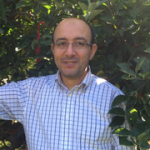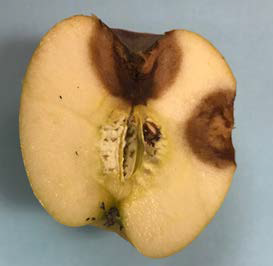By Achour Amiri, WSU Plant Pathology, April 2020 Downloadable pdf Bull’s eye rot (2020.04.15)
Bull’s eye rot (BER) is a continuous threat to apple and pear storability in the PNW and in many other growing regions. Recent surveys from Washington State showed that BER accounted for 8 to 10% of overall decayed fruit and 40% of the surveyed orchards had BER at frequencies ranging between 1% and 75% (Amiri and Ali 2016). Some cultivars, such as Golden Delicious and Pinata are highly susceptible to Neofabraea spp., but other cultivars such as Fuji, Cripps Pink, and Granny Smith can also be at risk, especially when rainy conditions occur before harvest.
Casual Organism
Bull’s eye rot is a major economic postharvest disease of apple and pear that can be caused by four Neofabraea species; N. perennans Kienholz, N. alba E.J. Guthrie, N. malicorticis H.S. Jacks and N. kienholzii Seifert, Spotts & Lévesque. In central Washington, BER is predominantly caused by N. perennans which also causes perennial cankers on apple trees. Neofabraea malicorticis is more widespread in western Washington where it causes Anthracnose cankers in addition to BER. Neofabraea alba is found more often on pear in Oregon, whereas N. kienholzii is the latest BER-causing species to be reported in the PNW.
Symptoms
BER symptoms of infections originating from lenticels show lesions that are depressed, circular, flat to slightly sunken with a light brown to dark brown halo around a lighter brown to tan center. Several spots may be visible on a single fruit. Infections that start from the stem-end or calyx-end will have the same coloration but are not sunken. Decayed tissue is dark brown in the inside with a dense consistency and a clear margin between decayed and healthy tissue. Usually, decayed tissue does not readily separate from the healthy tissue. BER lesions progress slowly in cold storage and as decay advances, cream-colored spore masses may appear at the center of the lesion (Fig.1). It is very difficult to differentiate between BER infections caused by the different Neofabraea species on fruit. Lesions of N. alba may look much paler than that of lesions caused by N. perennans, whereas N. malicorticis tend to show gray acervuli (small asexual fruiting body shaped like a hershy kiss) that are concentrically distributed at the center of the lesion.
Figure 1. Symptoms and signs of Bull’s eye rot (Neofabraea spp.) on apples and pears. Photo credit: Achour Amiri (WSU-TFREC)
Infection and Disease Cycle
In central Washington State where the majority of apple and pear orchards are planted, BER is mainly caused by N. perennans, which seems to be better adapted to the dry and semi-arid climate. BER of pear in Oregon was found to be often caused by N. alba. Neofabraea perennans can cause perennial cankers, on the tree, on which the fungus overwinters as acervuli and from which conidia are released when conditions become favorable in the spring and summer of the following season. Besides cankers, Neofabraea species can overwinter, as asymptomatic infections, in mummified fruits, pruned wood, leaf litter, and on grass around the orchard (Kohl et al. 2018). On pear trees, Neofabraea spp. may survive on dead bark.
Inoculum of Neofabraea spp. may also come from alternative hosts such as western crabapple (Malus fusca), which is thought to be the original host of anthracnose canker (Aguilar et al. 2017). The primary and secondary inoculums are water-splashed to limbs and fruits to cause infections between petal fall and harvest, when fruit are more susceptible. Infections are more frequent in rainy seasons and on late cultivars that tend to receive more rain. The fungus only infects fruit preharvest, and because of the dry growing season in the region, infections remain latent with symptoms expressed only after 3-4 months of storage. BER incidences as high as 20% can been seen especially in rainy seasons and on susceptible cultivars. BER does not spread from decayed to healthy fruits inside the bin in cold storage. The fungus grows between 0°C and 25°C (32°F-82°F), with the optimal temperature being 20°C (68°F). Growth declines significantly at temperatures around 30°C (>86°F) and above.
Cultural Controls
It is important to establish new plantings with clean stock free of visible cankers . Scout orchards, especially new ones, regularly for cankers. Early detection will help with management. In apple and pear orchards, prune and remove cankered branches to reduce overwintering inoculum and apply fungicides to dead bark to target potential surviving inoculum of Neofabraea spp. Water spreads the fungal inoculum and creates conditions conducive for fruit infection. Avoid overhead irrigationand , cycle over-tree cooling so that conditions do not remain wet in the canopy for prolonged periods of time. Ideally harvest fruit while they are dry and store immediately.
Chemical Controls
Pre and postharvest applications of fungicides are key to effective bull’s eye rot management. Before making a spray decision, consider the cultivar and weather conditions occurring during that season, as these two factors have a great impact on BER development in storage. Even though fruit become more susceptible closer to harvest, infection by Neofabraea spp. may occur anytime between bloom and harvest. Consider your fungicide timing. Studies have shown that treatments applied 18 weeks before harvest were more effective in controlling BER than those applied two weeks before harvest. The most effective preharvest fungicide is Topsin-M (FRAC 1) but other fungicides, such Pristine (FRAC 7 + 11), have shown good efficacy levels. The multi-site fungicide Ziram applied within two weeks before harvest has shown variable levels of efficacy against bull’s eye rot in the Pacific Northwest but is a good fungicide to include in the spray program alone or tank-mixed with other fungicides to enhance control and mitigate fungicide resistance.
Four different fungicides are currently registered to control postharvest decays of pome fruit (Table 2). Thiabendazole ( FRAC 1) is the most effective fungicide against bull’s eye rot followed by pyrimethanil (Penbotec). Fludioxonil (Scholar) has a low efficacy against bull’s eye rot and it is recommended to apply it in combination with thiabendazole, especially on susceptible cultivars or on lots with known bull’s eye rot history. Difenoconazole was registered for postharvest application on pome fruit in 2016 and has shown a better efficacy against bull’s eye rot compared to Scholar alone. Formulations exist to apply thiabendazole, pyrimethanil, and fludioxonil through thermonebulization (TNB, fog) exist already and a formulation for a fog application of Academy is pending. In Washington State, Academy can be applied via drench at harvest as long as packers can follow specific fungicide waste management practices (Waste Pesticide Program). Neofabraea species have a medium risk for fungicide resistance development, therefore, rotation of fungicides from different FRAC groups in orchards and warehouses is important to avoid selection for populations that are resistant to current fungicides especially for FRAC 1 fungicides (thiabendazole, Topsin-M).
List and efficacy of preharvest postharvest fungicides registered to control bull’s eye rot and other decay rots
Table 1. Preharvest Fungicides
| Active ingredient | Trade names | FRAC group | Rate/ac | Preharvest interval (PHI) (days) |
Registered for Apple |
Registered for Pear |
Efficacy against bull’s eye rot |
|---|---|---|---|---|---|---|---|
| Thiophanate-methyl | Topsin-M 70 WSB | 1 | 0.75-1 lb | 1 | + | + | Very good |
| Boscalid | Pristine | 7 | 18.5 oz | 0 | + | + | Good-fair |
| Fluxapyroxad | Merivon | 7 | 5.5 fl oz | 0 | + | + | Unknown |
| Pyraclostrobin | Pristine, Merivon | 11 | Check labels | 0 | – | + | Fair |
| Fenhexamid (allowed in non-bearing apple) | Elevate 50WDG | 17 | 1-1.5 lb | 0 | – | + | NA |
| Ziram | Ziram 76DF | M03 | 6 lb | 14 | + | + | Good-fair |
| Captan | Captan 50 WP | M04 | 6 lb/ 20-400 gal | 0 | + | – | Fair |
Table 2. Postharvest Fungicides
| Active ingredient | Trade names | FRAC group | Rate | Preharvest interval (PHI) (days) |
Registered for Apple |
Registered for Pear |
Efficacy against bull’s eye rot |
|---|---|---|---|---|---|---|---|
| Thiabendazole | TBZ, Mertect, eFog-99 | 1 | see label | NA | + | + | Very good |
| Pyrimethanil | Penbotec, eFog 160 | 9 | see label | NA | + | + | Good |
| Fludioxonil | Scholar, eFog80, Actimist | 12 | see label | NA | + | + | Low |
| Difenoconazole + fludioxonil |
Academy | 3 + 12 | see label | NA | + | + | Medium |
| Captan | Captec 4L | M04 | see label | NA | + | + | Low-fair |
For additional information, please consult the WSU Crop Protection Guide
Use pesticides with care. Apply them only to plants, animals, or sites listed on the labels. When mixing and applying pesticides, follow all label precautions to protect yourself and others around you. It is a violation of the law to disregard label directions. If pesticides are spilled on skin or clothing, remove clothing and wash skin thoroughly. Store pesticides in their original containers and keep them out of the reach of children, pets, and livestock.
YOU ARE REQUIRED BY LAW TO FOLLOW THE LABEL. It is a legal document. Always read the label before using any pesticide. You, the grower, are responsible for safe pesticide use. Trade (brand) names are provided for your reference only. No discrimination is intended, and other pesticides with the same active ingredient may be suitable. No endorsement is implied.
References
Aguilar CG., Mazzola M., and Xiao C.L. 2018. Control of bull’s eye rot of apple caused by Neofabraea perennans and Neofabraea kienholzii using pre- and postharvest fungicides. Plant Disease 102:905-910.
Amiri A., and Ali. MD.E. 2016. Prevalence of storage decays of apple: Lessons from the 2016 statewide survey.
Amiri A., and Pandit L.K. 2019. Evaluation of difenoconazole as postharvest fungicide to control ten major pathogens of pome fruit. APS-Pacific Division. Phytopathology 109-11-S3.8.
Henriquez JL., Sugar D., and Spotts RA. 2004. Etiology of bull’s eye rot of pear caused by Neofabraea spp. in Oregon, Washington, and California. Plant Disease 88:1134-1138.
Rosenberger and Xiao, 2014. Postharvest Diseases. pages 75-86 in Compendium of apple and pear diseases and Pests. Second Edition, American Phytopathological Society Press. St. Paul. MN
Spotts RA., Seifert KA., Wallis KM., Sugar D., Xiao CL., Serdani M., and Henriquez JL. 2009. Description of Cryptosporiopsis kienholzii and species profiles of Neofabraea in major pome fruit growing districts in the Pacific Northwest USA. Mycological Research 113:1301-1311.
Contact
 Dr. Achour Amiri,
Dr. Achour Amiri,
Postharvest Pathology
Tree Fruit Research and Extension Center
Wenatchee, WA
a.amiri@wsu.edu
509-293-8752
treefruit.wsu.edu articles may only be republished with prior author permission © Washington State University. Reprint articles with permission must include: Originally published by Washington State Tree Fruit Extension at treefruit.wsu.edu and a link to the original article.









